Affiliate disclosure: This post may contain affiliate links. Please see our Privacy Policy.
Reishi mushrooms are one of the easiest mushrooms to identify, and a great place to start for beginning mushroom foragers. They have no poisonous look-alikes, so they’re relatively safe as well. Though reishi are generally too tough to eat, their medicinal properties have been well documented.
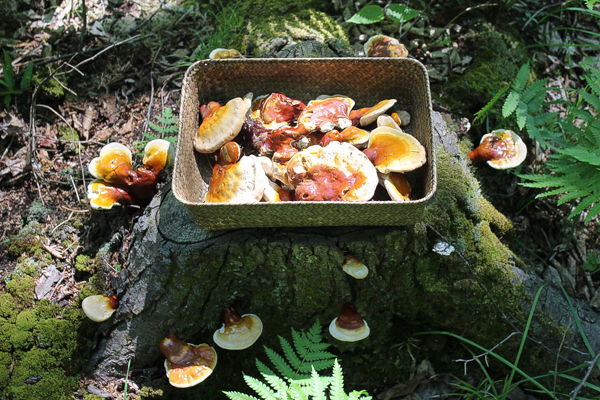
Table of Contents
Reishi mushrooms can be found around the world, growing in many different climates. Some occur in the cold, frigid climate of northern latitudes, while others grow abundantly in the tropics. They are decomposers typically found growing from the sides of large woody trunks. In some cases, they are known to be pathogenic, causing root and stem rot on living trees.
For the most part, their medicinal properties are the same and there is some argument that they’re actually the same species occupying different habitat niches.
All species grow on dead and dying trees and produce annually. Once you find reishi on a particular log or stump, they will continue to produce there every year until they’ve consumed all the wood substrate.
Reishi mushrooms are also known by the names lingzhi, mushroom of immortality, ten-thousand-year mushroom, herb of spiritual potency, varnish shelf and artists conk.
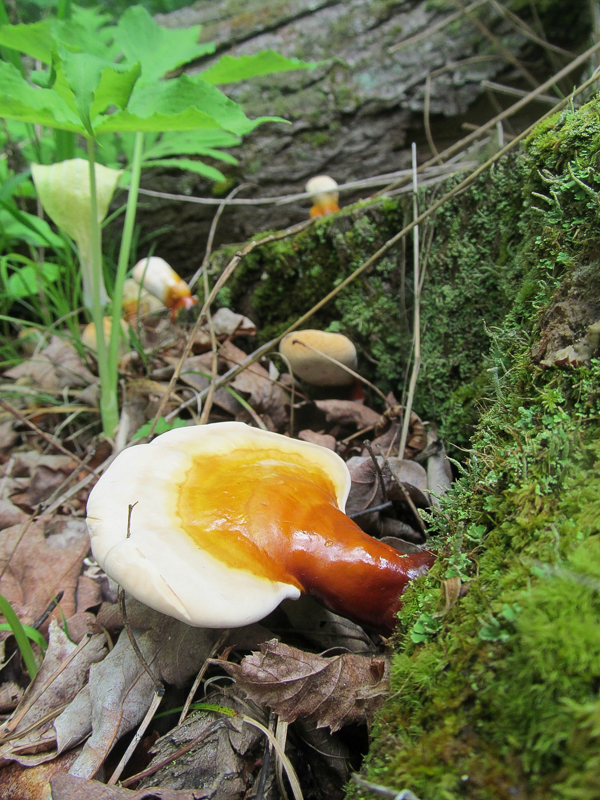
The “True” Reishi Mushroom
As you delve into the research on Reishi mushrooms, you’ll undoubtedly encounter the name Ganoderma lucidum. It’s a common sight in field guides, research articles, and all over the internet. However, it’s essential to know that this name has often been misused, even in much scientific literature.
This is because Ganoderma lucidum was initially used to describe a species that only occurs in Europe. Despite this, early mycologists believed that Ganoderma lucidum was cosmopolitan, and thus, this name was applied to similar species occurring worldwide. This includes similar Asian species used in traditional Chinese medicine for thousands of years. Due to this confusion, the name Ganoderma lucidum was used in much of the existing scientific literature, which primarily used Chinese cultivars and not the authentic Ganoderma lucidum from Europe.
As researchers began conducting genetic analysis on various Ganoderma species, they eventually realized that there are a lot of diverse species around the world. Today, the accepted name of the traditional Chinese varieties has been changed to Ganoderma sichuanense or, in some cases, Ganoderma linghzi. Like in Asia, North American species are also distinct from the European Ganoderma lucidum.
While there is some controversy regarding the medicinal properties of distinct types of Ganoderma, they are all considered medicinal and safe for consumption. The presence of triterpenes, one of the main medicinal components of Reishi mushrooms, can be easily recognized by a highly bitter flavor. While it’s not particularly delicious, it is a good sign that you have a medicinal variety.
Reishi Mushroom Identification
The mushroom itself is kidney or fan-shaped and has a distinctive red to orange color, and a shiny lacquered finish on the top. It’s a polypore, so it lacks gills, but the underside is white (or tan or grey in older specimens) and has pinprick-like dots. The flesh on the underside develops a brown/tan bruise when pressed.
Only harvest fresh mushrooms with white undersides as they can potentially harbor dangerous molds when the mushrooms are past their prime or bruised and damaged. Since they’re easily bruised and damaged during harvest, reishi should be preserved quickly after harvest.
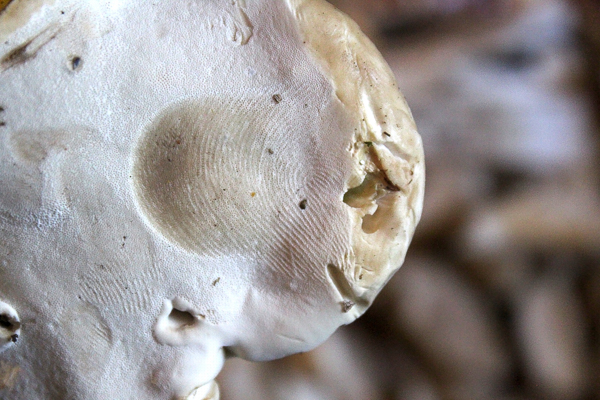
They vary in size from an inch wide to a foot wide and can be as much as 2 inches thick. More commonly, they’ll be 4 to 6 inches wide and 1/2 inch to 1 inch thick.
New growth on the leading edge comes in as white and gradually changes to red-orange. Young mushrooms that are rapidly growing may be mostly white as they emerge from the wood. The bright red-orange cap that is characteristic of hemlock reishi will come as they mature.
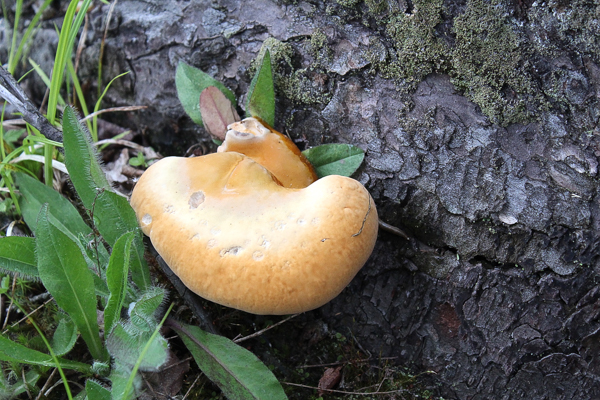
As reishi get older, their flesh becomes tougher and the bright cap begins to dull. On my land, reishi rarely make it more than a few days before the slugs begin to devour them.
The harvest season in central Vermont is right around the summer solstice, and I go out daily to make sure I catch the mushrooms before they’re slug eaten.
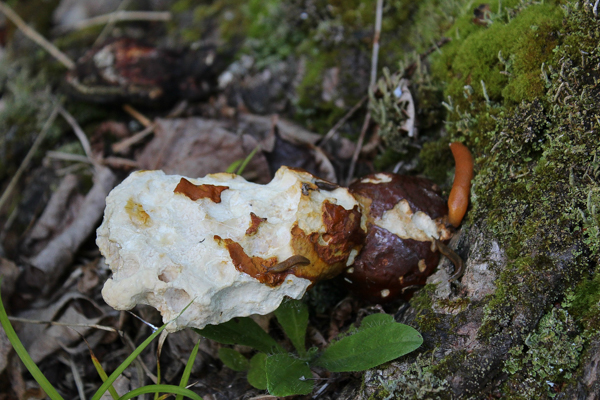
Reishi grows horizontally out of their host log, often with a very short or non-existent stem. They have a strong but pleasant woodsy scent, a bit like decomposing leaf mulch.
Spores emerge from the bottom side of the mushroom, and on logs where they’re growing one above the other, you’ll see spores released by the upper mushrooms dulling the caps of the mushrooms below. The spore print in all species is brown.
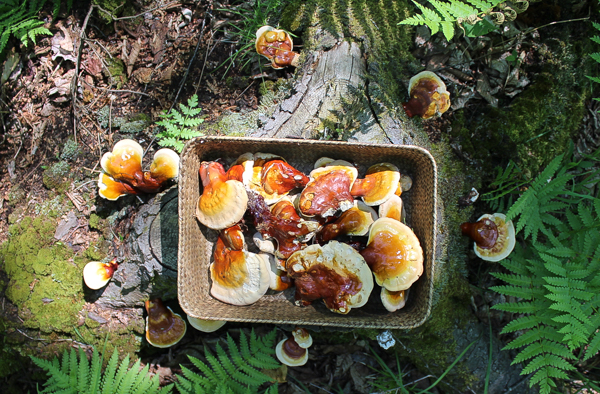
Reishi Mushroom Species
Identifying reishi mushrooms varies a bit from region to region as different species have evolved based on location. The genus Ganoderma has two main groups.
Section Ganoderma
This group contains the broad definition of “Reishi” mushrooms. These typically have a varnished “shiny” appearance on their surface (when not covered in spores) and are relatively spongy in texture. These mushrooms are generally short-lived and only grow for a couple of months before they begin decomposing.
The most common species in this group include:
- Ganoderma lucidum – Is the species used in traditional Chinese medicine. It grows on hardwood (especially oaks) in warmer regions, such as Asia, the South Pacific, Southern Europe and the Southeastern United States.
- Ganoderma tsugae – Found in the Northeastern United States, the species name “tsugae” means “hemlock tree” which tells you where you should begin looking for this species. Though it’s almost always found on hemlock, it can occasionally be found on birch or maple if they were growing close to hemlock. They can be found freshest between May and July. This species is also known as hemlock varnish shelf.
- Ganoderma curtisii – Distributed from Massachusetts to Nebraska, this species has an especially dramatic ochre-colored cap, that dulls as the mushroom ages. It has a matte rather than lacquered finish on its cap. Found on hardwood logs, usually oak or maple, but occasionally other hardwoods as well.
- Ganoderma sessile – A red shiny species that grows 3 to 16 inches across. The flesh is very soft and bendable, and unlike other species, if damaged the outer growth margin will produce a sap-like resin. Found on hardwood, usually oak or maple, but occasionally other hardwoods as well.
- Ganoderma oregonense – As its name suggests, this species is native to the pacific northwest where it grows on conifers. The fruiting body is very large and can be up to a meter across.
Other species include: G. boninense, G. carnosum, G. cochlear, G. flexipes, G. hainanense, G. martinicense, G. mediosinense, G. mexicanum, G. multipileum, G. multiplicatum, G. oerstedii, G. orbiforme, G. perturbatum, G. polychromum, G. ravenelii, G. resinaceum, G. sessiliforme, G. sichuanense, G. sinense, G. tropicum, G. tuberculosum, G. weberianum, G. zonatum
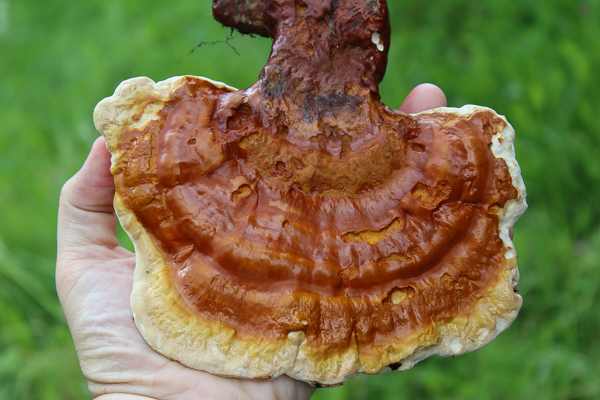
Applantum Complex
This includes all the tough polypores known as “Artist Conks.” These mushrooms are long-lived, often occurring for several years. These mushrooms are very tough and woody and do not contain the “varnished” look of Reishi mushrooms. They are called Artist Conks because you can draw on the bottom of their pore surface, and they quickly stain black.
These mushrooms are not bitter and, in my opinion, make a pretty delicious decoction. They have a light vanilla-like flavor that is quite pleasing. While this group hasn’t been studied nearly as well as Reishi, it is considered medicinal. Almost identical-looking Artist Conk mushrooms can be found growing worldwide in virtually any sort of climate. While these likely represent distinct species, they are broadly called the Ganoderma applanatum complex since they are morphologically similar and genetic studies are limited.
- Ganoderma applanatum – A particularly hard and woody reishi species, varying in size from 2 to 30 inches wide. Color is duller than others and lacks a lustrous shine. Very difficult to cut, and often must be cut with a saw into strips for drying. This species is an opportunist and can be found on many different tree species, both hard and soft wood.
Reishi Mushroom Look-Alikes
Reishi mushrooms have no poisonous look-alikes, making them ideal for the beginning mushroom forager. While it’s sometimes hard to distinguish between species of reishi mushroom, all reishi species are used in the same way. The fine distinctions between species are more academic than practical.
Be sure to only use fresh first-year reishi mushrooms with bright caps and white undersides. As the mushrooms age, the underside grows darker, turning tan or brown and the cap dulls. Older reishi mushrooms can harbor potentially harmful molds and should not be consumed.
Reishi can be confused with other polypore mushrooms, notably the red belted conk (fomitopsis pinicola). The red belted conk is a perennial mushroom, that’s hard and woody, unlike the spongy texture or reishi.
Rather than developing new mushrooms each year, it just grows a new ring around the edge. Unlike reishi, the red belted conk will not bruise on the pore side when pressed.
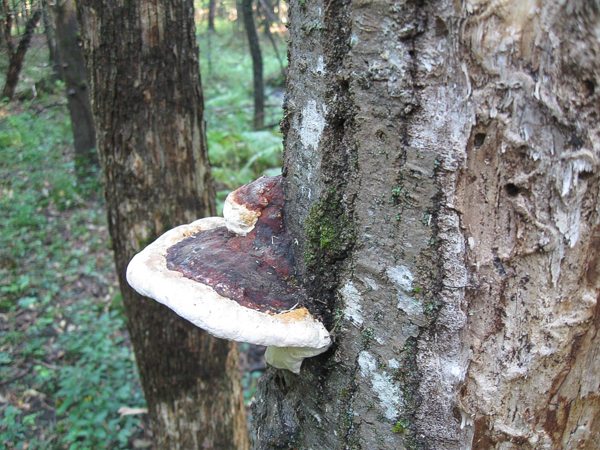
Harvesting Reishi Mushrooms
Be sure that the pore surface on the underside is white, ensuring that the mushroom is a young specimen. Reishi can either be gently pulled from the tree host or cut with a knife in softer specimens.
Reishi grow at the base of trees near the ground and often grow around plants found growing nearby. Be sure that the mushroom you harvest hasn’t grown around any toxic plants, especially poison ivy which can sometimes be found nearby.
Adverse Reactions to Reishi
Be careful taking reishi if you’re on other medication, especially medicine that affects the liver. There have been some rare but documented allergic reactions, involving skin rash and stomach upset, all of which stopped when reishi was discontinued.
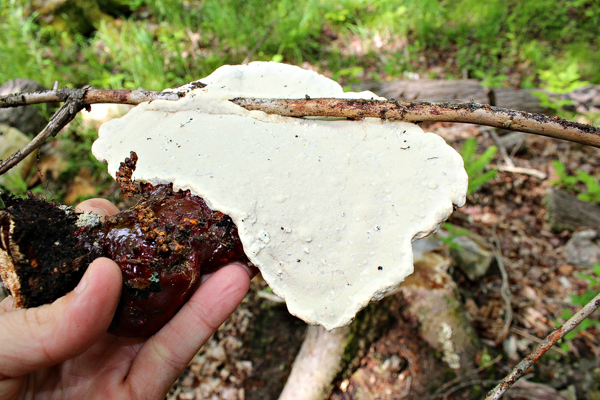
Storing Reishi Mushrooms
Reishi mushrooms spoil quickly after harvest unless they’re promptly dried. They will keep in a paper bag in the refrigerator for 3-5 days but are best when they’re promptly cut into thin strips and dried. Dried reishi mushrooms should be stored in an airtight container out of direct sunlight.
They can also be chopped and made into a reishi mushroom tincture directly after harvest, no drying required. Since reishi mushrooms have both water-soluble and alcohol-soluble constituents, a double extraction tincture is the best way to get all the medicinal benefits.
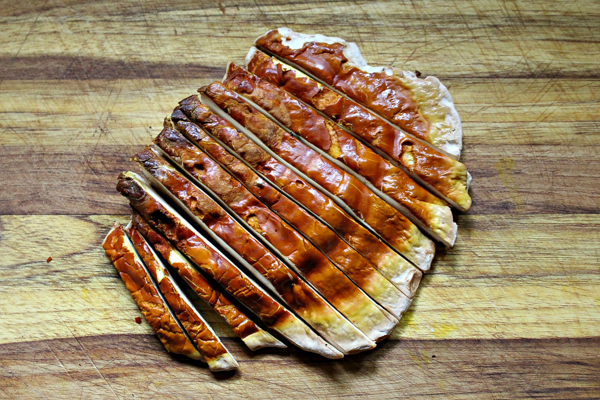
Reishi Mushroom Medicinal Properties
In a class of medicines known as Adaptogens, reishi mushrooms help you to adapt to cope with physical and mental stresses. It’s best taken daily over an extended period, as it often takes a few weeks for reishi to build up in your system to have a positive impact.
They’re known to be analgesic, anti-inflammatory, antibacterial, antiviral, antioxidant, anti-allergic and anti-tumor. Reishi mushrooms have also been shown to reduce blood pressure, blood cholesterol, blood sugar and reduce platelet aggregation that results in blood clots. Its effects on blood sugar were significant enough that it has been successfully used in the treatment of diabetes.
The antioxidant activity of compounds found in reishi mushrooms seems to target free radicals responsible for aging, and reishi helped reverse the effects of aging in lab mice. Reishi works to protect and strengthen the liver and has been successfully used for the treatment of chronic hepatitis B.
The cancer-fighting properties of reishi mushrooms are well documented in scientific literature. Reishi doesn’t seem to fight cancer cells outside the body in tissue cultures, suggesting that the main anticancer effects are achieved by strengthening a person’s immune system and helping their body fight off cancer rather than attacking cancer directly.
The most common way to prepare reishi mushrooms is as a strong tea, where thinly sliced mushrooms are simmered for extended periods (1 to 2 hours) to extract their water-soluble constituents. The medicinal components of reishi can also be extracted in an alcohol-based tincture. The dried mushroom powder can also be put into reishi capsules and taken as a daily immune-boosting supplement.
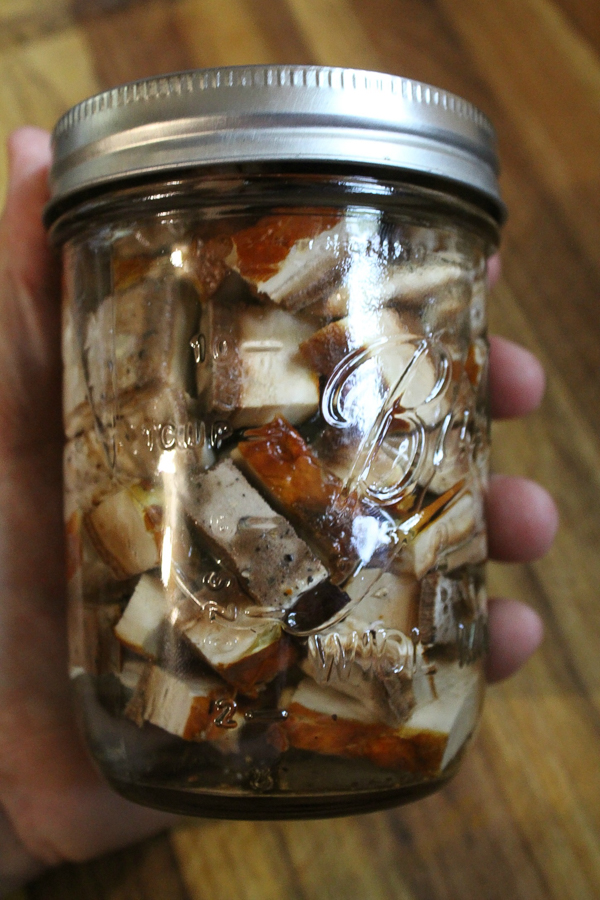
Cooking Reishi Mushrooms
Though often too tough and woody to eat, they are technically edible. If you’d like to try eating one, harvest a very young mostly white growing tip just after it comes out of the log or stump. Dice it finely and sauté.
I imagine you’ll be unimpressed, but give it a try.
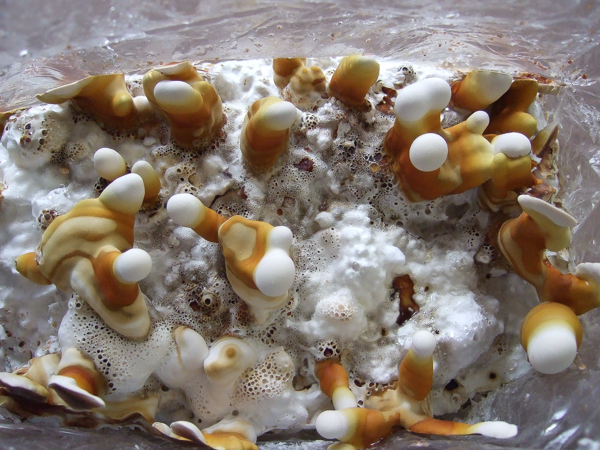
Cultivating Reishi Mushrooms
If you have dead oak logs or stumps available, try growing your own by inoculating with reishi dowel plugs.
I have not been able to find hemlock reishi spores or plugs online, but I have had success placing a freshly harvested hemlock reishi on top of a freshly cut hemlock stump. Our stump produced mushrooms the following year and has continued to be productive.
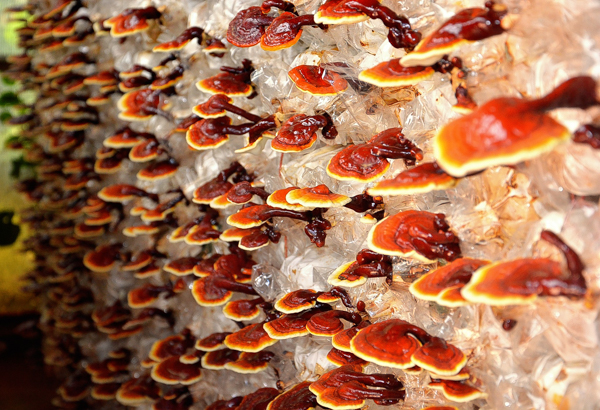
Mushroom Foraging Resources
Excited about getting out into the woods and foraging mushrooms this year? Here’s a bunch of other easy-to-identify mushrooms:
Or if you’re feeling extra ambitious, you can always try your hand at cultivating shiitake mushrooms.
For more information on foraging reishi mushrooms, try any of these references:
- The Complete Mushroom Hunter
- National Audubon Society Field Guide to Mushrooms
- Mushrooming without Fear
- Mushrooms of the Upper Midwest
- Mushrooms of the Pacific Northwest
- Mushrooms of New England and Eastern Canada
- Mushrooms of the Midwest to New England
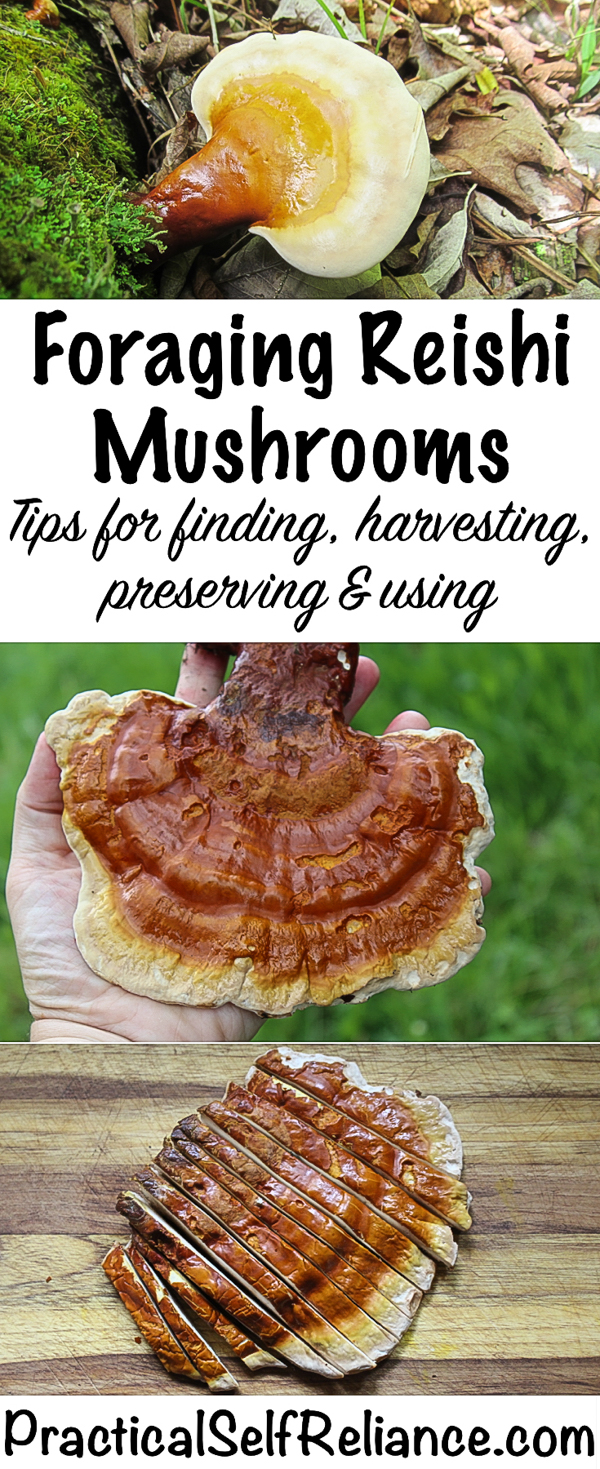

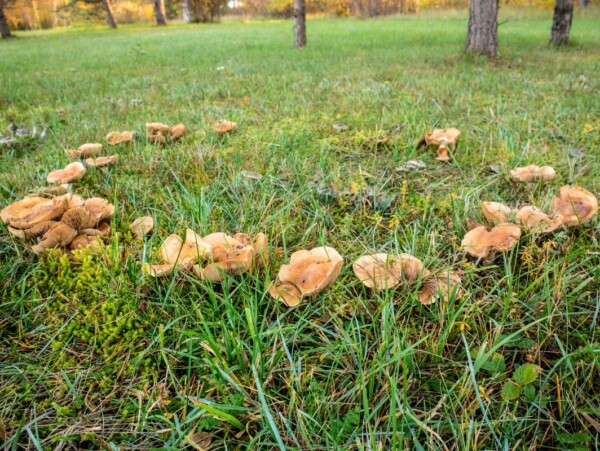
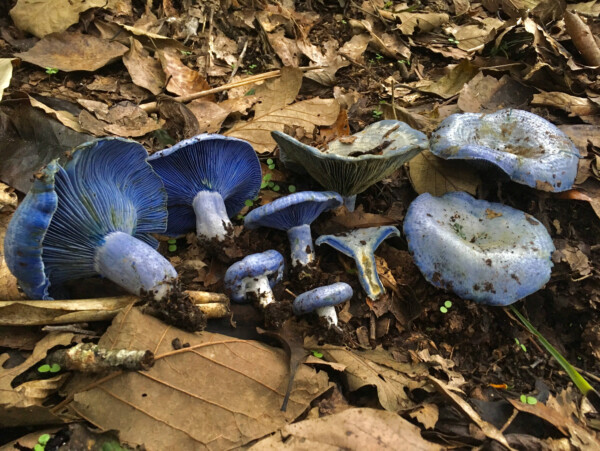
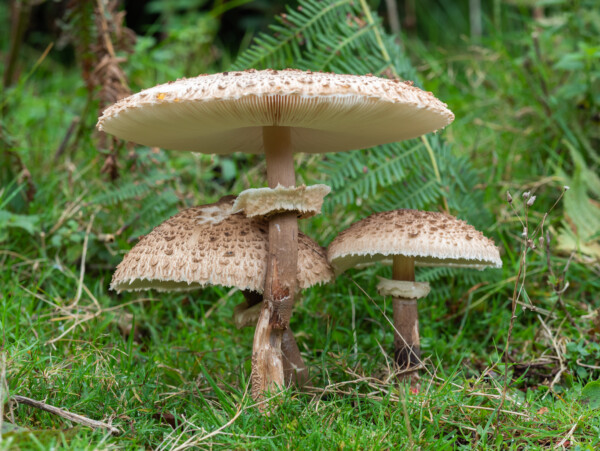










Thank you so much for sharing your knowledge. I have grown reishi at home from a bag. What came up did not look like the half circle, but what I have learned is called reishi antlers. They are tall skinny ‘tubes’. Have you come across these and do you think they would have the same medicinal properties?
Thanks for your time!
It is my understanding that for the most part different reishi species carry the same medicinal benefits.
I really appreciate your time to answer. Thanks so very much!
You’re very welcome.
Last year June 2020 I came across the most abundant patch of Reishi – of which I harvested considerately of nature – and I went back this year and they are completed rotted and gone! They were on several dead trees and now there is literally none to be found… I’m so curious what happened because I suspected they would continually reproduce… Any thoughts?!
They typically will continue to fruit on the same surface. Maybe the weather conditions weren’t exactly right at the time that you checked or maybe they had already fruited again before you had a chance to return. The timing of the fruiting is variable depending on the weather conditions.